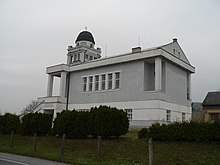Hrabová
| Hrabová | ||||
|---|---|---|---|---|
|
||||
| Basic data | ||||
| State : |
|
|||
| Region : | Olomoucký kraj | |||
| District : | Šumperk | |||
| Area : | 810 ha | |||
| Geographic location : | 49 ° 51 ' N , 16 ° 57' E | |||
| Height: | 290 m nm | |||
| Residents : | 645 (Jan. 1, 2019) | |||
| Postal code : | 789 01 | |||
| License plate : | M. | |||
| traffic | ||||
| Street: | Leština - Úsov | |||
| structure | ||||
| Status: | local community | |||
| Districts: | 1 | |||
| administration | ||||
| Mayor : | Jiří Linhart (as of 2009) | |||
| Address: | Hrabová 113 789 01 Zábřeh |
|||
| Municipality number: | 553221 | |||
| Website : | hrabova.zabrezsko.cz | |||

Hrabová (German Raabe ) is a municipality in the Czech Republic . It is located seven kilometers southeast of Zábřeh and belongs to the Okres Šumperk .
geography
Hrabová is located at the foot of the Úsovská vrchovina ( Ausseer hill country ) in the Müglitzer Furche ( Mohelnická brázda ). The village is located on the left side of the March along the tributary Hrabovský potok. To the west of Hrabová the Moravská Sázava and the Vitošovský náhon flow into the March. In the north are the Vitošov limestone quarries, behind it rises the Trlina (523 m), to the northeast the Bílý kámen ( White Stone , 588 m), to the east the Polanka (498 m) and southeast the Malá Polanka (450 m).
Neighboring towns are Vitošov and Dolní Brníčko in the north, Strupšín and Rohle in the northeast, Janoslavice in the east, Bezděkov u Úsova in the southeast, Dubicko and Bohuslavice in the south, Lukavice in the southwest, Zvole in the west and Rájec , Ráječek and Leština in the northwest.
history
The village is in the 11th or 12th century after the after the local chronicle Lhotensystem have been founded and was originally called Lhuota . The first documentary mention of the village belonging to the Úsov lordship was in 1344. The Úsov estates belonged to the Moravian margraves, who passed them on to their vassals for loyal services. The lords of Hrab also belonged to the feudal lords. The place was given the name Lhota Habrová , which is derived from the Hrab , to distinguish it from the numerous Lhoten . Later, the name of the village took place after the short form Hrabová, which is commonly used in parlance . In 1447 the Tunkl von Brníčko Hrabová acquired and struck the village including the Vitošov farm as well as the local mill, quarry and lime kiln to the rule of Zábřeh . In the 15th century the Tunkl had the Raab pond built in the Marchaue west of the village, which was drained again in the 19th century.
After the abolition of patrimonial Hrabová / Raabe formed with the district Vičov and Vítešov / Witschau from 1850 a municipality in the Hohenstadt district . In 1898 the cooperative dairy of the villages of Hrabová, Vitošov, Dubicko and Leština was established in Hrabová. In 1894 the manufacturer F. Schmeiser set up a mechanical weaving mill in the former Vitošov mill. At the beginning of the 20th century, the Hájek company expanded the lime distillery with further ring kilns, opened up new quarries and built its own power station. In 1920 the community consisted of 98 houses and had 840 inhabitants. During this time the Protestant movement "Pryč od Říma" (Lot of Rome) was very well received in the village and the majority of the residents joined the Evangelical Church of the Bohemian Brethren . This was mainly due to the work of the charismatic vicar Rudolf Šedý, who traveled all over Europe. The prayer hall was also built on Šedý's initiative. In 1930 Hrabová had 854 inhabitants. While only Czechs lived in Hrabová, the population of Witschau consisted mostly of Germans who worked in the Schmeiser factory.
After the Munich Agreement , the place was annexed to the German Reich in 1938 and belonged to the Hohenstadt district until 1945 . In 1939 840 people lived in Raabe. After the Waffen-SS executed five men from Lesche / Leština at Steinmetz's house on May 8, 1945 , Czech residents of Leština fell into pogrom mood and attacked the Germans living in Vitošov on May 9. The Schmeiser weaving mill was placed under state administration in May 1945 and later liquidated. The Moravskoslezské elektrotechnické závody (MEZ) set up a production facility in the factory.
In 1960 a cider and fruit distillery was built in the former dairy. At the end of 1960 the Okres Zábřeh was dissolved and the municipality was assigned to the Okres Šumperk. A disused MiG-15 had been standing by the swimming pool since 1967 . Between 1971 and 1973, the Rudné doly Jeseník company built a new lime kiln in Vitošov. Between 1976 and 1990 Hrabová was incorporated into Dubicko . In 1991 608 people lived in the 150 houses of the community. In July 2008, the increasingly cannibalized aircraft wreck was removed.
Vápenka Vitošov sro is one of the three largest lime works in the Czech Republic. The fruit distillery operates today as Lihovar Hrabová sro
Community structure
No districts are shown for the municipality of Hrabová. Hrabová to hear the settlement Vitošov ( Witschau ).
Attractions
- Prayer house of the Evangelical Church of the Bohemian Brothers , built 1928–1933, declared a cultural monument in 2003
- Stone cross from 1792, south of the village on the road
- Vitošov limestone quarries
- chapel

